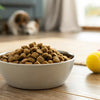Should Water Be Added to Dry Dog Food? Exploring the Benefits and Considerations
- Houndsy
Table of Contents
- Introduction
- The Benefits of Adding Water to Kibble
- The Potential Drawbacks of Adding Water
- Practical Tips for Adding Water to Kibble
- Conclusion: Should You Add Water to Dry Dog Food?
Introduction
As devoted dog owners, we often find ourselves contemplating the best ways to enhance our furry friends' dining experiences. One question that frequently arises is, should water be added to dry dog food? According to recent studies, a significant percentage of dog owners express concern about their pets' hydration levels, particularly those that consume primarily dry kibble. This concern highlights the importance of understanding how we can optimize our dogs’ nutrition and hydration through their meals.
In this blog post, we will explore the various aspects of adding water to dry dog food, including the benefits, potential drawbacks, and practical tips for implementation. By the end of this article, we aim to provide you with a comprehensive understanding of whether adding water to kibble is a good idea for your dog, helping you make informed decisions about your pet's diet.
We will delve into the impact on hydration, digestion, and dental health, as well as how it may influence your dog's feeding routine. We invite you to reflect on your own pet's eating habits as we guide you through this important topic. Our primary takeaway will focus on how a simple act—adding water to dry dog food—can enhance the feeding experience for both you and your canine companion.
The Benefits of Adding Water to Kibble
Enhanced Palatability
One of the most immediate benefits of adding water to dry dog food is its ability to enhance palatability. Many dogs can be picky eaters, and dry kibble may not always excite them. By introducing water, we can unlock and intensify the food's aromas and flavors. This can be particularly beneficial for dogs recovering from illness or those that are generally less enthusiastic about their meals. If your dog has ever turned its nose up at dinner, consider how a splash of water might transform mealtime from mundane to mouth-watering.
Improved Hydration
Hydration is crucial for maintaining our dogs' overall health. Many dogs do not drink enough water, which can lead to dehydration. By adding water to their kibble, we can effectively sneak in additional hydration without them even realizing it. This is especially beneficial for dogs that are prone to kidney issues or urinary tract infections, as adequate hydration helps maintain optimal kidney function and supports urinary health.
Easier to Chew and Digest
Adding water to kibble softens the food, making it easier for dogs to chew, especially for puppies, senior dogs, or those with dental issues. Soaking the kibble can reduce the risk of choking and ensure that all dogs can enjoy their meals without discomfort. Furthermore, softer kibble can facilitate digestion, making it gentler on your dog’s stomach. This is particularly important for older dogs, whose digestive systems may not be as robust as they once were.
Dental Health Considerations
While it might seem counterintuitive, adding water to kibble can also be beneficial for dogs with dental problems. Hard kibble is often marketed as a dental health product, as the chewing action can help scrape away plaque. However, dogs with existing dental issues may struggle with this hard texture. By moistening the kibble, we provide a tooth-friendly alternative that allows them to enjoy their meals without the pain associated with chewing hard food.
The Potential Drawbacks of Adding Water
Risk of Spoilage
While there are clear benefits to adding water, it is essential to consider potential downsides. One significant concern is the risk of spoilage. When kibble is moistened and left out for an extended period, it can create a breeding ground for harmful bacteria. This can lead to gastrointestinal upset or more severe health issues if consumed. To mitigate this risk, it is crucial to serve the hydrated kibble immediately and discard any uneaten portions after a set time, ideally within 60 minutes.
Loss of Nutritional Value
Another potential drawback of adding water to kibble is the possibility of nutrient loss. Some vitamins and minerals may dissolve into the water, particularly if the kibble is soaked for too long. This could diminish the overall nutritional value of the meal, especially if the soaked kibble becomes a regular part of your dog’s diet. If you are considering this practice, it may be wise to consult with a veterinarian to ensure that it won’t compromise your dog’s nutritional intake.
Altered Feeding Routine
Changing your dog’s food texture by adding water can also impact their feeding routine. Some dogs may take longer to eat wet kibble, while others may not adjust well to the change. If your dog is used to crunching their food, suddenly introducing a softer texture could lead to confusion or reluctance to eat. It’s essential to monitor your dog’s response to this change and make adjustments as necessary.
Overeating Risks
Moistening kibble can enhance its palatability, which may lead to overeating, especially in dogs that already tend to gobble down their meals quickly. The easier-to-eat, flavorful kibble could tempt your dog to consume more than they need, potentially leading to weight gain or digestive issues. To prevent this, we recommend measuring out portions carefully and monitoring your dog’s eating habits.
Practical Tips for Adding Water to Kibble
If you decide that adding water to your dog’s kibble is the right choice, here are some practical tips to ensure a smooth transition and optimal results:
Start Slowly
If your dog is not accustomed to eating moistened kibble, start by adding a small amount of water and gradually increasing it over time. This allows your dog to adjust to the new texture without overwhelming them.
Use Warm Water
Using warm water can enhance the flavor of the kibble even further by releasing its aromas. However, it’s crucial to avoid using hot water, as this can scald your dog’s mouth. Aim for a temperature that is warm to the touch, similar to a lukewarm bath.
Serve Immediately
To prevent spoilage, always serve the moistened kibble immediately after adding water. If your dog doesn’t finish their meal, it’s best to discard any uneaten portions after about 60 minutes. This practice helps reduce the risk of bacterial growth and keeps your dog safe.
Monitor Your Dog’s Response
Every dog is different, and their preferences can vary widely. After adding water to their kibble, observe how your dog reacts. If they seem to enjoy the new texture, you may have found a winning combination. However, if they exhibit any signs of discomfort or reluctance to eat, consider adjusting the amount of water or returning to dry kibble.
Conclusion: Should You Add Water to Dry Dog Food?
Ultimately, the decision of whether to add water to dry dog food depends on your dog’s specific needs and preferences. For dogs that struggle with hydration, are picky eaters, or have dental issues, adding water can significantly enhance their feeding experience. However, it’s essential to be mindful of potential drawbacks such as spoilage and nutrient loss.
We at Houndsy believe that elevating the dog-feeding experience is crucial for the well-being of our furry companions. Our flagship product, the Houndsy Kibble Dispenser, is designed with convenience and functionality in mind, allowing you to serve perfectly portioned kibble without the mess. With its ergonomic design and auto-locking mechanism, it ensures that your dog’s meals are served fresh and on time.
If you're interested in simplifying your pet care routine while enhancing your dog's feeding experience, we invite you to explore the Houndsy Kibble Dispenser. Together, we can make mealtime a joyful and enriching experience for your beloved pet.
FAQ
1. Can I add any type of water to my dog's kibble?
- It’s best to use clean, filtered water for moistened kibble. Avoid using flavored or sugary water, as this can lead to unwanted health issues.
2. How much water should I add to dry dog food?
- Start with a small amount, such as a quarter cup of water for a typical serving of kibble, and adjust based on your dog’s preferences and needs.
3. Is it safe to leave moistened kibble out for long periods?
- No, it’s important to serve moistened kibble immediately and discard any leftovers after about 60 minutes to prevent spoilage.
4. Will adding water to kibble make my dog gain weight?
- Adding water can enhance palatability, leading to overeating in some dogs. Monitor your dog’s food intake and adjust portion sizes as needed.
5. Should I consult my vet before changing my dog’s diet?
- Yes, if you have concerns about your dog’s diet or health, it’s always a good idea to consult with a veterinarian for personalized advice.












